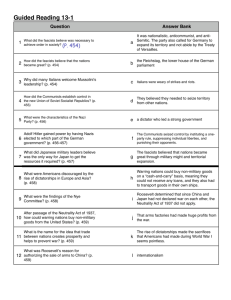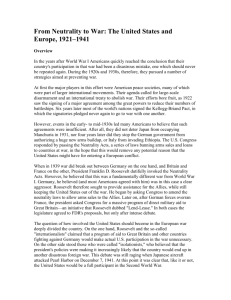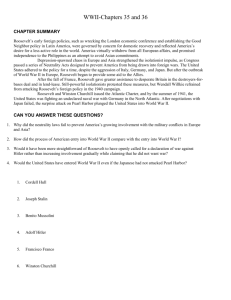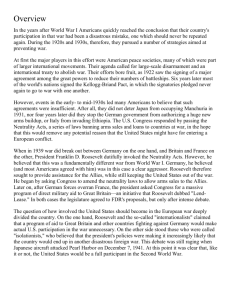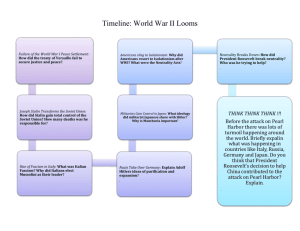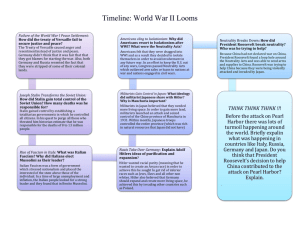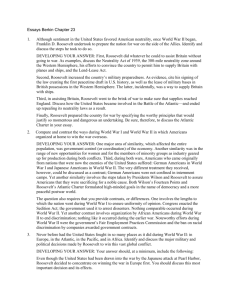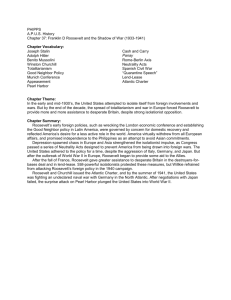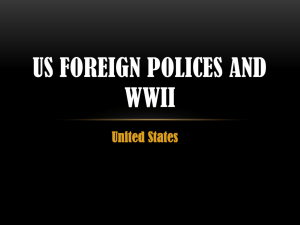AMH Chapter 13 Part 2 - Woodridge High School
advertisement
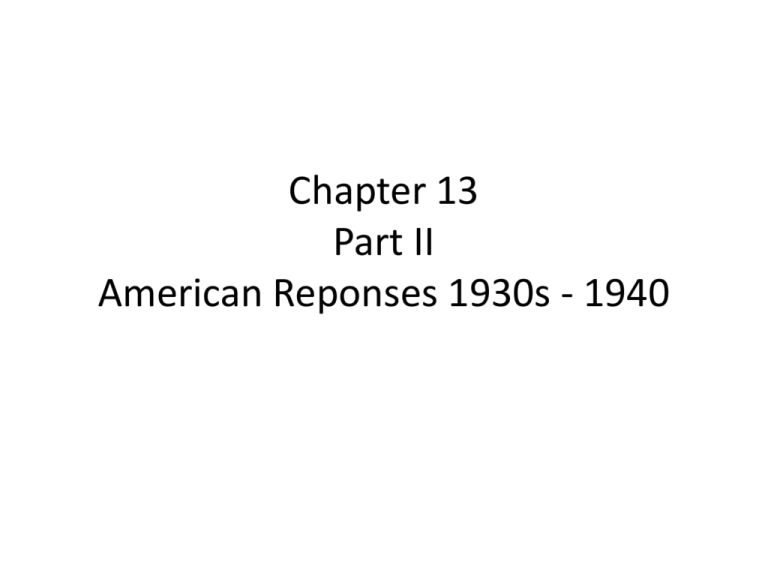
Chapter 13 Part II American Reponses 1930s - 1940 Isolation and the Nye Report • American isolationism grew after World War I and people felt that weapon manufacturers had tricked the United States into going to war. • This impression was only furthered when the Nye Committee held hearings that documented the huge profits these businesses made during the war. • This suggested they had influenced the United States to enter the war. • After the Nye Report, even more Americans turned toward isolationism. Neutrality Acts • • • In response to these feelings, Congress passed three neutrality acts between 1935 and 1937. The Neutrality Act of 1935 made it illegal for the United States to sell arms to any country at war. Congress passed the Neutrality Act of 1937 requiring warring nations to buy all nonmilitary supplies from the United States on a “cash and carry” basis. – • • Loans were not allowed. The countries had to send their ships to the United States to pick up the supplies. This was to prevent attacks on neutral American ships that would pull the country into a European or global conflict. FDR’s View • President Roosevelt knew that ending the Depression was the nation’s first priority. • He understood his countrymen’s feelings, but he was not an isolationist. • Roosevelt believed in internationalism, the idea that trade between nations helped to prevent war. Neutrality • When Japan attacked Manchuria, Roosevelt decided to help China. • He authorized the sale of weapons to China. • He argued that the Neutrality Act did not apply, since neither country had declared war. • He warned the nation that it was dangerous to stand by and let “an epidemic of lawlessness” infect the world. Divided • The United States was divided at the beginning of Germany’s war with Britain and France. • President Roosevelt declared the United States neutral two days after Britain and France declared war. • Despite this, Roosevelt wanted to help the two nations in their struggle against Hitler. Neutrality Act of 1939 • He asked Congress to revise the neutrality laws to eliminate the ban on arm sales to nations at war. • The result was the Neutrality Act of 1939. The law allowed warring countries to buy arms from the United States, but only on a “cash and carry” basis. • The public supported the president’s decision to help the allies as long as the arms sales were not carried on American ships. Need for Destroyers • Soon U.S. neutrality would be tested. Britain had lost nearly half its naval destroyers. • It needed to purchase destroyers from the United States, but lacked the cash. FDR Finds Loophole • Roosevelt created a loophole. – He exchanged 50 American destroyers for the right to build American bases in Britishcontrolled parts of Bermuda and in the Caribbean. • The act did not apply because the deal did not involve a sale or any purchases. • Most Americans accepted the deal with the British, since they favored offering limited aid to the Allies. Lend-Lease Act • After President Roosevelt was reelected to his 3rd term (which was unprecedented before), he began to expand the nation’s role in the war. • He removed the cash requirement of the Neutrality Act with the Lend-Lease Act. • This allowed the United States to lend or lease arms to any country “vital to the defense of the United States.” • Congress passed the act by a wide margin. • The United States began leasing weapons to Britain. Hemisphere Defense Zone • Technically, the United States was still neutral and could not protect British cargo ships, hindering getting the arms to Britain. • Roosevelt then introduced the hemispheric defense zone. • The purpose of the hemisphere defense zone was for the United States to protect British supply ships in the Atlantic while still remaining neutral. • He declared the entire western half of the Atlantic to be neutral. • This way, U.S. Navy ships could patrol the western Atlantic and reveal the location of German ships to Britain. Atlantic Charter • • • • • • Winston Churchill and Roosevelt met to discuss the Atlantic Charter in 1941, an agreement that committed their nations to democracy and free trade. It committed the United States and Britain to a postwar world of democracy, nonaggression, free trade, economic advancement, and freedom of the seas. Fifteen other nations signed the charter that year. Soon after, a German submarine fired on an American destroyer. Roosevelt ordered American ships to “shoot on sight” German ships. Germany retaliated, and the United States found itself drawn further into the war. Japan and Asia • Britain needed much of its navy in Asia to protect itself against a Japanese attack. • Japan depended on the United States for key materials, including steel and oil. • Wanting to hinder Japanese aggression, Roosevelt restricted the sale of strategic materials, including fuel and iron. • Furious, the Japanese signed an alliance to become a member of the Axis. Japan and Asia • Japan sent troops into Indochina, now a direct threat to Great Britain. • Roosevelt responded by freezing Japanese assets in the United States. • He reduced the amount of oil sent to Japan and sent General Douglas MacArthur to the Philippines to build American defenses there. Prepping for War • Roosevelt made it clear the oil embargo would end only if Japan withdrew its troops from Indochina. • Japan continued to prepare for war while it negotiated with the United States. • Neither side would back down. – On December 7, 1941, Japan attacked Pearl Harbor. Pearl Harbor Pearl Harbor Stats • Battleships – 4 battleships sunk (including the U.S.S. Arizona) – 3 battleships damaged – 1 battleship grounded • • • • • 3 cruisers damaged 3 destroyers damaged Nearly 200 aircraft destroyed 2,402 killed 1,247 wounded Hitler and Germany • Although Germany and Japan were allies, Hitler was under no obligation to aid Japan. • Hitler hoped that German assistance to the Japanese would lead to Japan's support for Germany against the Soviet Union. • He believed the time had come to declare war. • On December 11, Germany and Italy both declared war on the United States. Hitler had greatly underestimated U.S. strength.
